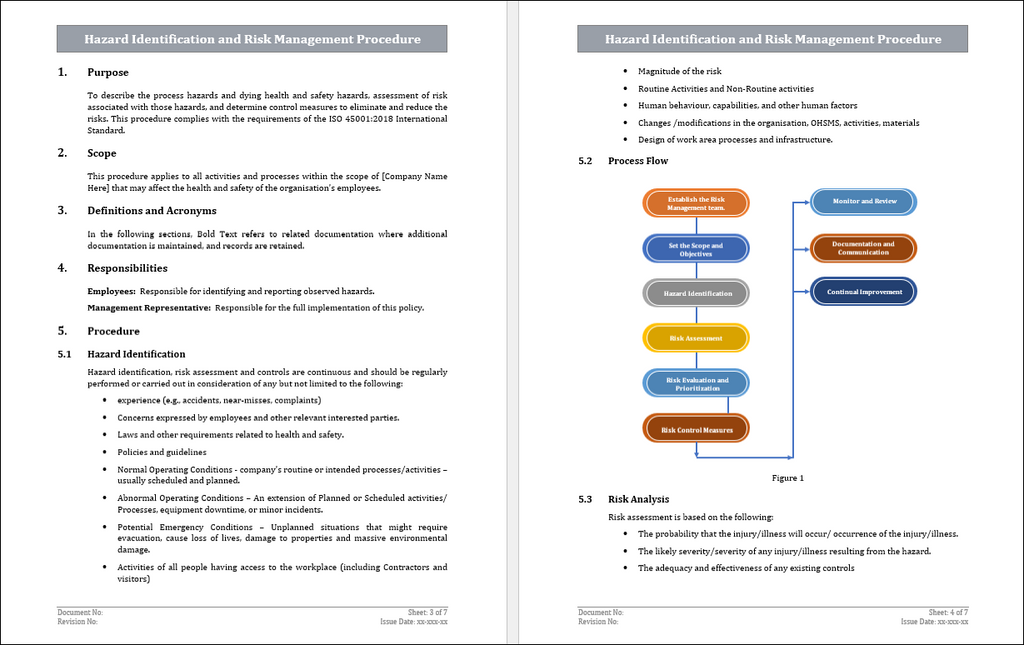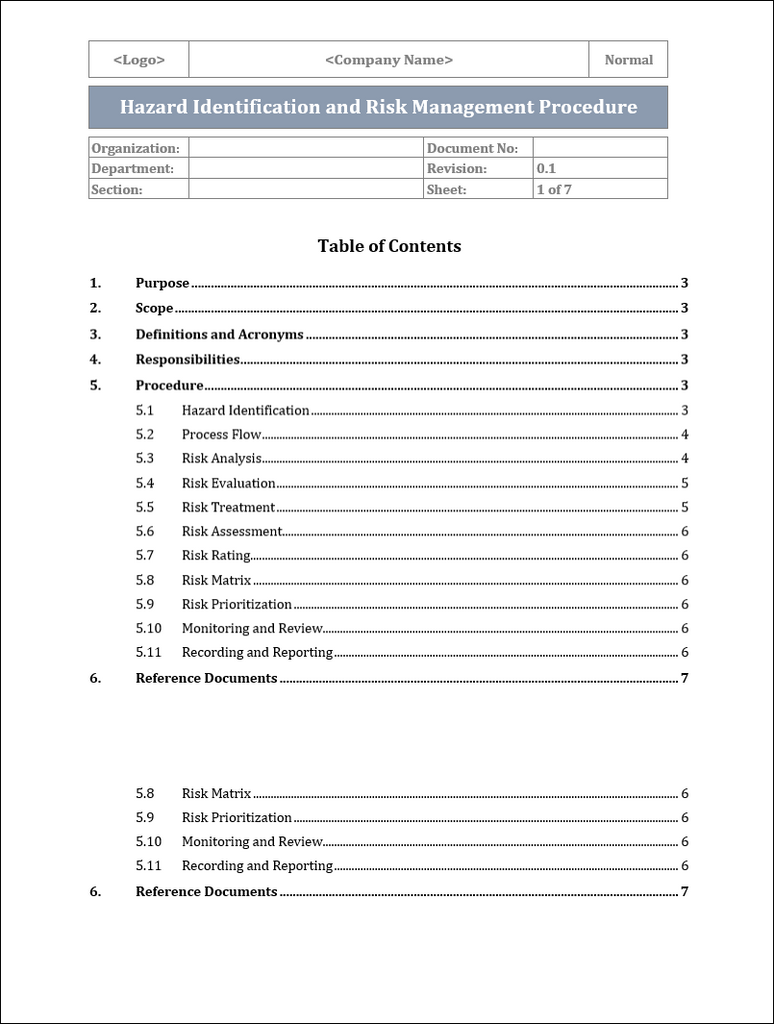ISO 45001 Hazard Identification and Risk Management Procedure Template
Introduction
The Hazard Identification and Risk Management Procedure for ISO 45001 Template is a crucial tool for businesses looking to ensure the health and safety of their employees. Hazard identification and risk management are critical components of any successful health and safety management system, and this template provides a comprehensive framework for organizations to identify, assess, and mitigate potential risks in the workplace. By implementing this procedure, businesses can comply with ISO 45001 standards and create a safer work environment for their employees.

Importance Of Hazard Identification And Risk Management In ISO 45001
Hazard identification and risk management are crucial to ISO 45001, the international occupational health and safety management system standard. By identifying potential workplace hazards and assessing their associated risks, organizations can prevent accidents, injuries, and illnesses among their employees. Hazard identification involves recognizing any potential sources of harm or danger in the workplace, such as dangerous machinery, hazardous chemicals, or unsafe working conditions.
Once hazards have been identified, organizations must assess the risks associated with them. This involves determining the likelihood of an incident occurring and the potential consequences if it does. Organizations can implement appropriate controls to mitigate or eliminate risks by understanding the risks.
Effective hazard identification and risk management ensure employees' safety and well-being and help organizations comply with legal requirements and industry standards. By proactively addressing hazards and risks, organizations can prevent costly incidents, reduce absenteeism, and enhance their reputation as responsible employers.
Developing A Hazard Identification And Risk Assessment Template
1. Hazard Identification: Include a detailed list of potential hazards that may be present in the workplace or activity being assessed. This can include physical, chemical, biological, ergonomic, and psychosocial hazards.
2. Risk Assessment: Develop a systematic process for evaluating each identified hazard's likelihood and potential consequences. This can be done using a risk matrix or other risk assessment tools.
3. Risk Control Measures: Outline specific control measures that can be implemented to eliminate or mitigate the identified hazards. This can include engineering controls, administrative controls, and personal protective equipment.
4. Responsible Parties: Assign roles and responsibilities to individuals or teams for implementing and monitoring the effectiveness of the risk control measures.
5. Monitoring And Review: Establish a schedule for monitoring and reviewing the hazard identification and risk assessment process to ensure that it remains up-to-date and effective.
6. Documentation: Keep detailed records of the hazard identification and risk assessment process, including the identified hazards, risk assessments, control measures, and monitoring activities.
7. Training: Ensure all employees involved in the hazard identification and risk assessment process receive appropriate training to identify hazards, assess risks, and implement control measures.
8. Continuous Improvement: Encourage feedback from employees and stakeholders to improve the hazard identification and risk assessment process continually. This can include identifying new hazards, updating control measures, and improving communication and reporting mechanisms.

Benefits Of Hazard Identification And Risk Management Procedure
Effective risk management relies heavily on proper training and communication within an organization. Here are some strategies for ensuring that training and communication are effectively implemented to manage risks:
1. Provide Comprehensive Training: Ensure employees at all levels receive training on risk management principles, processes, and procedures. This training should be ongoing and tailored to each individual's specific roles and responsibilities within the organization.
2. Foster A Culture Of Risk Awareness: Encourage open communication about potential risks and empower employees to speak up if they notice any issues. Ensure that there are clear channels for reporting risks and that all employees understand their role in managing risks.
3. Utilize Multiple Communication Channels: In addition to formal training sessions, use a variety of communication channels to keep employees informed about risks and risk management strategies. This could include emails, newsletters, intranet updates, and regular meetings.
4. Encourage Collaboration: Foster collaboration between different departments and teams to ensure that risks are identified and managed holistically. Encourage open communication between teams and provide cross-functional training and knowledge-sharing opportunities.
5. Provide Ongoing Support And Resources: Ensure that employees have access to the necessary resources and support to manage risks effectively. This could include tools, templates, guidance documents, and access to experts who can provide advice and assistance.
6. Monitor And Evaluate Effectiveness: Regularly assess the effectiveness of training and communication strategies related to risk management. Solicit employee and stakeholder feedback to identify improvement areas and make necessary adjustments.
Conclusion
Implementing a comprehensive Hazard Identification and Risk Management Procedure is crucial for ensuring a safe and healthy work environment by ISO 45001 standards. This template provides a structured approach to identifying hazards, assessing risks, and implementing controls to mitigate potential risks in the workplace. Organizations can proactively manage risks and prioritize safety in their operations by utilizing this template. Hazard Identification and Risk Management Procedure for ISO 45001 Template today to enhance your risk management practices and promote a safety culture within your organization.


